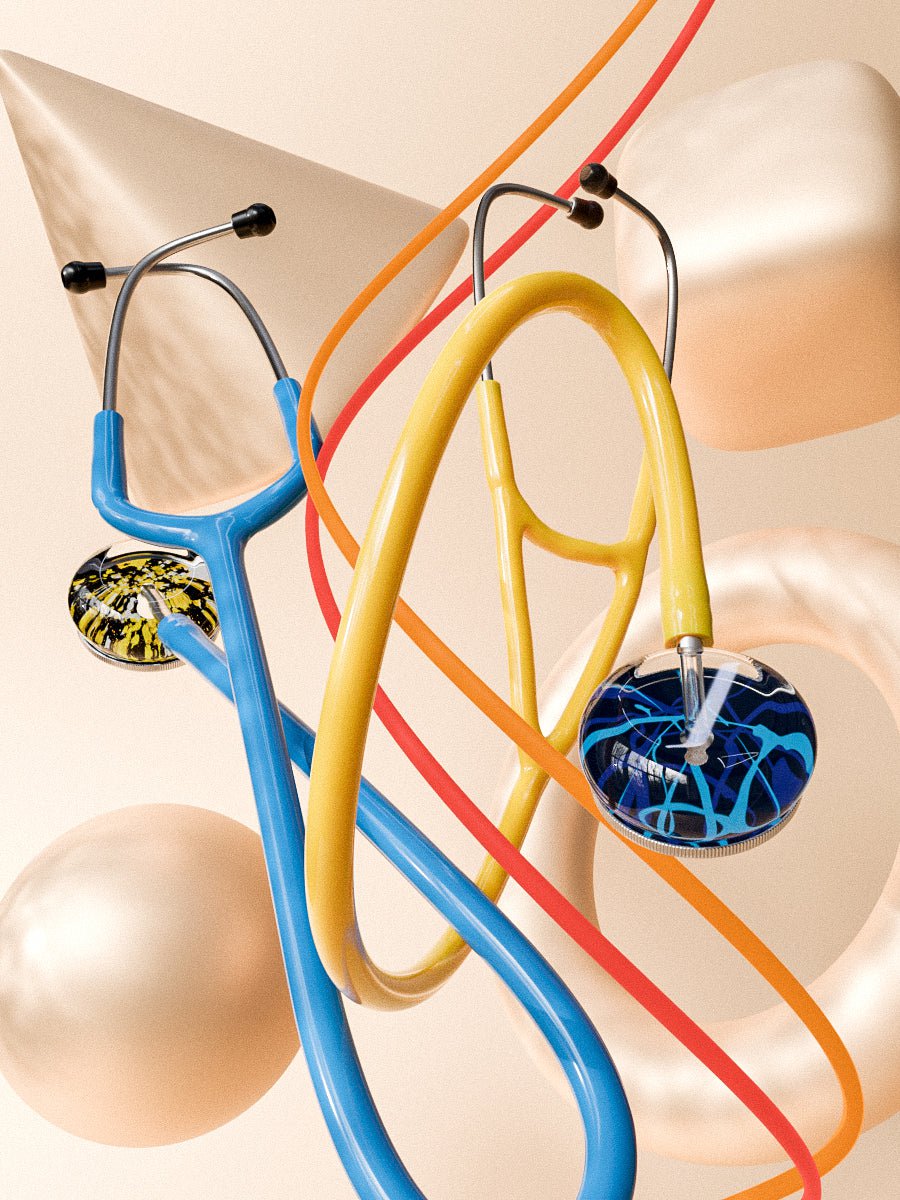Before deciding on whether or not you can change your stethoscope tubing, let's take a look at how the stethoscope is made. A standard stethoscope must have an earpiece, tubing, complete with its length, and a chest piece. Though there are electric stethoscopes available in the market, the standard ones with the three main components are still the most common. You can learn more about the Ultrascope personalized stethoscopes on our homepage.
A stethoscope tubing is that part of a stethoscope that is soft and flexible. It transmits and maintains the diaphragm or bell transmitted frequencies to the ears. This is the process that allows for sounds coming from a patient to be heard by the medic.
What could go wrong with the tubing?
Just like it is with all the things that we use daily, wearing out of a stethoscope tubing is normal as healthcare workers would attest to. These very important pieces of equipment are used for long shifts to take care of the necessary patient needs that are provided every day. This means that health care workers will often be on the lookout for new stethoscopes or a replacement of some of the parts.
The tubing is the most common component of a stethoscope that would require replacing. It however takes some good level of knowledge and time to undertake the replacement procedure. Knowing how to do it right is of great importance so that you don't end up with a dysfunctional stethoscope.
When you replace the tubing, you'll basically be removing the bond that holds the original tubing and the other parts of the stethoscope. Once you get a new tubing, it might feel like you are getting back your new stethoscope without having to spend as much money. But in reality, the initial bonding that was there before within the tubing will have been lost.
It would not be a surprise if the original hearing quality of the stethoscope will have been lost. This is something that no one would wish for. Though you may be able to purchase tubing from most sites which you can install by yourself to your stethoscope, most experts do not advocate for this. This is due to the justified fear that quality may be tampered with.
Before purchasing a tubing for replacement, it's important to understand exactly which type you are looking for. Let's take a look at the available types.
Tubing Types
Tubing can either be designed for the stethoscope that functions with a single tube, or for a double lumen stethoscope. The model is what determines the type of tubing. The double lumen design is mostly preferred as it's usually partitioned towards either the right or left hemispheres. This makes the sound originating from the bell or diaphragm clearer.
As with all other eventualities, it's a commonly agreed fact that prevention is better than cure. Knowing how to keep your tubing functional for a long time is very important.
How to Keep Tubing Crack Free
As unbelievable as it may seem, something as inconsequential as your natural body oils can make your tubing crack. This is especially so because of the regular contact when the stethoscope is hanging around the neck. If you have to hang it at the neck for convenience, let it be strictly under the collar to minimize contact with your skin. Better still, you can keep it in the front pocket. Though this may not look cool, it'll sure keep your tubing intact for longer.
Another common cause of tube cracking is the regular use of rubbing alcohol during cleaning. As important as it is to keep the stethoscope sterilized, excessive cleaning with rubbing alcohol will cause cracking. To protect the tubing, you can use the rubber protectant that is often used on car dashboards to treat your stethoscope tubing at least once every month. It's important to note that most of the latest stethoscope tubing can withstand alcohol and skin oils which makes them last longer and withstand regular use plus cleaning.
Even with maximum care taken, there's always a chance that the tubing will need changing at some point. Tubing replacement is important when cracking has occurred. Failure to change the tubing will lower the performance of the stethoscope and make it look mangled. To fix a damaged tube, you'll be required to purchase a new tubing that is consistent with your stethoscope model.
The cost may vary depending on where you opt to buy from and the type of stethoscope. Depending on what brand of stethoscope you have, there's a possibility for free parts for replacement and this can be a real advantage. In such a circumstance you'd need to reach out to the company's customer support and make a request for tubing replacement.
After you have accessed the right tubing, it's time to change to the new one in the following easy steps:
Step by Step Guide in Changing a Stethoscope Tubing
- Remove the damaged tubing. This will be easy if the tubing is not old and dry. By twisting the old tubing from the diaphragm and binaural, you'll easily get it out. If the tubing is worn out, you'll need to cut it off then use a small alcohol-soaked rag to clean the remnants from the diaphragm and the binaural.
- Put the new tube. The process of replacing the new tube is a lot easier than that of the old tube removal. You'll just need to twist the tubing onto the binaural and the diaphragm. That is all that you'll need to do to have your stethoscope look and probably function as well as new.
What to Look for When Buying a Stethoscope
If you desire to have your stethoscope for a long time while experiencing perfect functionality, there are a few things that you'll need to consider.
Buy the right one
If you are buying a stethoscope for the first time, ask around for recommendations. When still in training, let your instructor advise you on the most appropriate. If you are a practicing health practitioner, do some research on which one suits you best. It may not necessarily be the most expensive or the cheapest, but ensure that it suits your preference.
Make it Unique
Picking one with a not-so-common color will clearly make you stand out, and who wouldn't want this? With most stethoscopes behind either blue or black, go out of your way and pick a yellow one. This may not only serve to distinguish you from the pack but may also serve as a deterrent to thieves. It's not uncommon to leave a stethoscope on the desk for a few minutes and then come back to find it missing. When yours looks unique, one will have to think twice before picking it.
How to Keep Your Stethoscope Clean
Make a habit of cleaning your stethoscope often using the proper cleaning agents. These can be:
Wipes
When picking wipes to clean your stethoscope, choose the ones with an antibacterial formula. Though this may not the best option in keeping the stethoscope germ-free, it'll provide some level of cleanliness.
Soapy Water
This is the fastest way of cleaning your stethoscope. All you'll need to have access to is a source of water and a good detergent.
Alcohol
The most effective way of keeping your stethoscope disinfected is with the use of isopropyl alcohol. Though prolonged usage of it may affect the tubing, it still remains a convenient way of cleaning using alcohol pads or wipes.
Hand cleaners
The hand cleaning soaps that contain ethanol are ideal for quick cleaning of most medical equipment including the stethoscope. This is particularly in areas where there's water scarcity.
Conclusion
Taking good care of your stethoscope will make it last as long as it possibly can, according to the manufacturer. Though this may not always be possible for those stethoscopes that are used frequently, there's still the possibility of replacing the worn-out parts in order to retain the sound quality.





